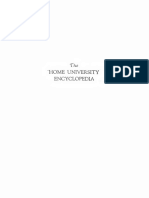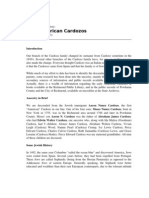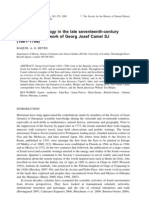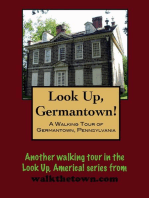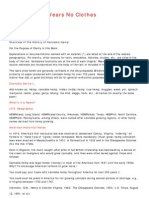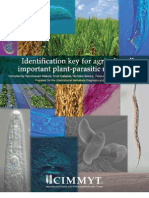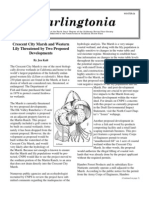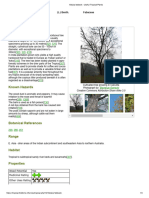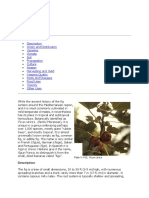The First Hostas in North America Thomas Hogg, American Hosta Pioneer
The First Hostas in North America Thomas Hogg, American Hosta Pioneer
Uploaded by
HostagirlCopyright:
Available Formats
The First Hostas in North America Thomas Hogg, American Hosta Pioneer
The First Hostas in North America Thomas Hogg, American Hosta Pioneer
Uploaded by
HostagirlOriginal Title
Copyright
Available Formats
Share this document
Did you find this document useful?
Is this content inappropriate?
Copyright:
Available Formats
The First Hostas in North America Thomas Hogg, American Hosta Pioneer
The First Hostas in North America Thomas Hogg, American Hosta Pioneer
Uploaded by
HostagirlCopyright:
Available Formats
THE FIRST HOSTAS IN NORTH AMERICA THOMAS HOGG, AMERICAN HOSTA PIONEER
2009 by W. George Schmid (Revised and expanded from Chapter 5, The Genus Hosta - Gibshi Zoku () 1991 The North American botanical and horticultural literature of the 18th century mentions nothing about hostas. A diligent search under all the names given to the genus Hosta, namely Aletris, Hemerocallis, Niobe, Bryocles, Hostia, Funckia and Funkia located no specific references. In the early 19th century, however, hosta names begin to appear in the horticultural literature. Surprisingly, already in 1839, just a few years after von Siebold's return to Holland from Japan, an entry on Funkia shows up in The American Flower Garden Directory edited by the U.S. florist Robert Buist. He mentions three species, all beautyful. One was H. ventricosa (as Funkia caerulea), with blue flowers. also H. plantaginea, (as Funkia japonica) and H. Undulata, (as Funkia variegata). Buist annotates the latter with the note: The latter is yet rare, and but recently introduced (into Europe) from Japan. Also mentioned is the fact that this genus has been separated from Hemerocallis. In the 1854 edition, Buist added one new species to that year's edition of his directory: Funkia laurifolia, early blue, its identity not known definitely, but I daresay it was probably H. Lancifolia. Edward Sprague Rands Garden Flowers appeared in 1866 and shows that the selection available in the United States had increased as compared to Buists listings. E.S. Rand includes the following:
Funkia grandiflora Siebold ex Lemaire 1846
in Flore de Serres 2:10 (1846) tab. 158-159 (ic. M. Van Houtte del.) (original in the Schmid collection)
1
(in Sprague 1866 as Funkia ovata)
Hosta ventricosa
Cultivated mass planting at Hosta Hill 2007.06.22
H. ventricosa as Funkia ovata. H. plantaginea as Funkia subcordata. H. sieboldiana as Funkia sieboldiana. H. Undulata as Funkia undulata. H. Lancifolia as Funkia lancifolia. H. sieboldii as Funkia albomarginata. These accounts indicate that hostas were imported into the United States from Europe in the early 1800s though some actually may have came earlier: H. plantaginea (as Hemerocallis plantaginea) and H. ventricosa (as Hemerocallis caerulea), both in the 1830s. In the 1850s U.S. horticulturists and plant collectors gained access to Japan. Among them was Hall (George R. Hall, 18201899, physician and plant collector, U.S.A.), who came to Japan in 1855. By 1860 he had a large collector's garden in Yokohama and according to Keough et al., (1982) the first plants sent directly from Japan to America arrived in 1861 and probably came from Hall. Many new plants were represented in this garden and it was there that Fortune found his celebrated male Aucuba japonica. It is not known if Hall cultivated hostas. In addition to the hostas imported by Thomas Hogg directly from Japan in the 1870s, additional hostas originating with von Siebold were also imported into the United States from Holland or by way of England. This we can postulate with some certainty, because many hostas were labeled with and retained the names given by von Siebold. By the 1890s several other hostas made an appearance in North America and by this time the unstable H. Undulata certainly had sported to the variety H. Undulata Erromena, which was sold under a number of different names. Plant exchanges between U.S. botanists and their European counterparts increased thanks to improved technology for maintaining plants in good health and improved transportation in the late Victorian era. No doubt, additional hostas were brought into the country by early travellers visiting Europe. By 1900 the hosta selection in North America reflected the European selection very closely, right down to the names used. 2
One notable example is that of Funkia lanceolata, offered by the nursery of Jacob W. Manning of Reading, Massachusetts. I examined a specimen, which the Bailey Herbarium obtained in 1897 and found it labeled: Funkia lancifolia Sprengel; trade name Funkia lanceolata. From the nursery of Jakob W. Manning, Reading, Mass. cat. 1897; Sep. 26-27 1898. Von Siebold imported this hosta in 1829 and listed it in his first catalog of 1844 also as Funkia lanceolata. In this case the European source is proven, because the epithet lanceolata was never used in Japan. Thus, with exception of Hogg's importations, all of the hostas in the United States around 1900 originated from European stock. As pointed out earlier, hosta names had been included in North American garden directories since at least 1839. Hosta advertising by way of catalog listings probably began with Hogg, although a date cannot be established. But even before his time some plants and seeds were certainly imported or brought in by travellers returning from Europe and Japan. A few hostas found their way to the United States not by way of Europe but through direct importation from Japan. One of the leading plant collectors and Hosta Pioneers involved was Thomas Hogg. THOMAS HOGG, JR. (18191892) A few years after Commodore Perrys first expedition to Japan, the Opening of Japan had begun in earnest in 1862, the same year both von Siebold and Fortune returned to Europe. The days of the Great Collectors of Japanese flora were about to end. The Russian Maximowicz (Carl Johann Maximowicz, 18271891, botanist, USSR) prepared to leave Japan in 1864. The Englishmen Richard Oldham (18381864, botanist, United Kingdom) and John Gould Veitch (18391870, botanist and nurseryman, United Kingdom) had sent back their collections. The American Hall, (mentioned earlier), who conducted a nursery business in Yokohama, had also left for home in 1862. Collecting in the countryside of Japan had become a very dangerous task. What the Japanese called the Invasion of the Barbarians, which began in 1855 with Commodore Perry generated a lot of ill will and the feudal princes, seeing their political power and status taken away by Europeans and Americans had a fanatical hatred for the foreigners. Many naturalists and plant collectors felt it was time to go. Thomas Hogg, Jr. was the oldest son of the celebrated English florist and horticulturist Thomas Hogg of Paddington, who at one time was head gardener to William Kent. Thomas was born in 1819. Shortly after his birth, his family emigrated to the United States where in 1820 they established a nursery and florist business on Manhattan Island, not far from where 23rd Street and Broadway intersect today. There was considerable demand for nursery stock and the business soon flourished and had to move to larger grounds at Seventy-ninth Street and the East River. The elder Hogg made important connections with plant collectors who supplied him with all kinds of new plants. Among them David Douglas, (17981834, botanist, Scotland, UK) of Douglas Fir fame, who collected in North America during the period from 1823 to 1834. The elder Thomas Hogg died in 1855 and left his nursery to Thomas, Jr. and his younger son James, who was born shortly after the arrival of the Hogg family in America. In 1855, Commodore Perry made his first expedition to Japan and regular trade between the United States and Japan soon developed. When the American Consul and U.S. Marshal Townsend resigned in 1862, President Lincoln sent Thomas Hogg, Jr. to Japan to take over the post of U.S. Marshal for Japan. By then. Fortune and von Siebold were safely back in Europe. Hogg remained until 1870 but returned in 1873 for another stay in a private capacity remaining until 3
1875, during which time he reportedly served as an agent for the Japanese Customs Service. Hogg sent many fine plant discoveries back to America, where his brother James built the Hogg nursery into one of the best sources for Asiatic and Japanese plants. Among his introductions were a number of lilies, of which he made a special study. He also brought into horticultural use the Kousa dogwood (Cornus kousa chinensis), umbrella pine (Sciadopitys verticillata), several wisterias and clematis, and many other plants, including hostas. As with Fortune, Hogg found it easier and safer to purchase his plants in the nurseries of Tokyo and Yokohama so did very little collecting in the wild. By the 1860s, the Japanese were beginning to realize the great commercial H. Undulata (as Funkia undulata) value of their plants, so began to collect them (a von Siebold import 1829) and give them fancy names for the sole purpose of selling them to Western collectors. These names were virtually entirely descriptive in nature. Several Japanese descriptive words were used: Shirofukurin ( ) (white margin) and Kifukurin ( ) (yellow margin). The trade in Japanese plants became so important that most plants exported after 1862 were bought from dealers, rather than collected in the wild. Oldham reported a flourishing plant business in the streets of Yokohama taking place as early as 1863. But even before this floral trade, collecting in the wild had become risky business, as described earlier, so many collectors, including Hogg, preferred to purchase their plants. The Japanese plant vendors also realized that variegated plants commanded higher prices and Hogg, who was looking for variegated plants to expand his already extensive Asiatic plant offerings, bought a number of his variegated hosta introductions from these street merchants. It is not known exactly, when Hogg brought what was to become his famous introduction, what the Japanese called Fukurin Giboshi () to America. Undoubtedly, Hogg brought at least 2 hostas under this name from Japan: One is now identified as H. Decorata, another is H. Undulata Albomarginata. Both have green leaves with white margins and may have been identified by the same name Fukurin Giboshi ( ) by uninformed Japanese sellers. Since Western gardeners had difficulty with the Japanese name it was quickly changed to Funkia Thomas Hogg and it should be noted that to casual observers young plants of these two cultivars are virtually identical which may explain why both were sold as Funkia Thomas Hogg by the nursery. The plants, being rare, were probably never allowed to grow to maturity due to constant propagation. Cultivars under this name in England are considered to be Hosta Undulata Albomarginata, while in North America the name is applied to H. Decorata. The time of Hogg's importations is most commonly quoted as in the horticultural literature around the turn of the century but this is incorrect. He unquestionably brought hostas with him when he returned from his second trip in 1875 (Hansen and Mssel 1964, 1974), or had them shipped back shortly before or after his departure and reports indicate a Funkia Thomas Hogg 4
H. Crispula Hosta Hill 1989 H. Decorata
was growing at the Lexington Botanic Garden in the early 1880s described as a deep green Funkia with the edge white. The Hogg nursery experienced its peak of prosperity as one of the leading suppliers of Asian plant material in the 1870s. Hogg travelled to Europe several times after 1875 and he undoubtedly brought his Funkia Thomas Hogg and other plants with him. Hogg died in 1892 at the age of 73. The nursery carried on for some time after his death before it ceased to operate. The Hogg nursery exported hostas to Europe; Hosta Undulata Albomarginata' went to England as Thomas Hogg's Funkia and is still called by that name on occasion. Probably because they look so much alike as small plants, both H. Decorata and H. Undulata Albomarginata went to Holland, also under the name Thomas Hogg's Funkia. The presence of H. Decorata is confirmed by the account of the German geneticist A. Ernst, who published a paper in 1918, (Bastardierung als Ursache der Apogamie im Pflanzenreich, Jena, pp. 446447. 1918.) describing genetic experiments mit einer von Tubergen in Harlem, Holland, bezogenen Thoss. Hoegg Funkia, i.e. a hosta named Thoss. Hoegg Funkia he obtained from the Tubergen nursery in Holland which turns out to be H. Decorata. Ernst's research involving pollination of hostas took a number of years to complete so he would have acquired his hostas around 1910. It can be safely assumed that Funkia Thomas Hogg (= H. Decorata) was in Holland before 1900. This date fits agreeably with de Noter's 1905 date for his Funkia alba Thomas Hogg hort., described as a white-flowered cultivar in his work Hemerocallis an Funkia in Vertaald en van opmerkingen voorzien door H. Witte. Nederland Tuinbouwblad Sempervirens, No. 3:445447. Hylander (1954), in his synonymy for H. Decorata, stated this taxon was not conspecific with the hostas labeled today H. Thomas Hogg. Although de Noter's descriptions are quite difficult to interpret, I believe that the French Thomas Hogg was in fact H. plantaginea so the name attached by de Noter suggests this hosta also came from Hogg. In this way H. plantaginea came full circle: from Europe to America where it was mentioned as early as 1839 (Buist, 1839, 1854; Rand 1866), only to be exported back to Europe around the 1880s as Funkia Thomas Hogg or Funkia Alba Thomas Hogg. 5
Recorded use of the name Thomas Hogg for at least three cultivars gave rise to considerable confusion. For this reason, the name has been eliminated as a cultivar name This should in no way diminish the great contribution Hogg made to the introduction of hostas into U.S. commerce. Thus, Thomas Hogg was one of the first to introduce hostas to the U.S.A. References: Buist, R., 1839. The American Flower Garden Directory. E. L. Carey & A. Hart, Philadelphia, p. 40. Buist, R., 1854. The American Flower Garden Directory. A. Hart, Philadelphia, p. 44. Ernst, A. 1918. Bastardierung als Ursache der Apogamie im Pflanzenreich, Jena, pp. 446447. Hansen, R. and H. Mssel. 1964. Eine bersicht ber die in Europa eingefhrten und im Handel verbreiteten Arten und Sorten der Gattung Hosta, Jahresbericht, Staatliche Lehr- und Forschungsanstalt fr Gartenbau, Weihenstephan, Freising, Germany; p. 47. Hylander, N., 1954. The Genus Hosta in Swedish Gardens, Acta Horti Bergiani, Vol. 16, 11:331-420. Keough, J. S., J. Powell and B. W. Ellis. 1982. North American Horticulture. Compiled by the American Horticultural Society. C. Scribner's Sons, New York. Rand, Edward Sprague. 1866. Garden Flowers. Schmid, W. George. 1991. The Genus Hosta - Gibshi Zoku (). Siebold, P. F. von, 1825. Einige Wrter ber den Zustand der Botanik auf Japan. Acad. Cs. Leopold Nova Acta, 14, pp. 670696. Siebold, P. F. von, 1824. De histori naturalis in Japonia statu. Oken, Isis, Batavia. Siebold, P. F. von, 1827. In schedula (L). Siebold, P. F. von, 1844. Kruidkundige Naamlijst von oud en nieuw ingevoerde Japansche planten van het jaar 1824 tot 1844. Jaarb. Kon. Ned. Mij Aanomoed. Tuinbouw, p. 29. Witte, W., 1892. Vaste planten, 3. Nederland Tuinbouwblad Sempervirens, 21:4952.
Early Imports from Japan: The three variegated Undulatas
L to R: H. Undulata; H. Undulata Albomarginata; H. Undulata Univittata Hosta Hill @ W.G. Schmid 1987.05.16 6
You might also like
- The New Growing The Mesembs PDFDocument67 pagesThe New Growing The Mesembs PDFPaco Melero100% (1)
- Dum Barton Oaks PDFDocument77 pagesDum Barton Oaks PDFEmilia RaggiNo ratings yet
- History of Bonsai in The Western WorldDocument86 pagesHistory of Bonsai in The Western WorldHilmi ErolNo ratings yet
- Emily Dickinson and Japanese Flowers HerbariumDocument30 pagesEmily Dickinson and Japanese Flowers HerbariumVictor Hugo Loaiza SeguraNo ratings yet
- Book 1 History of The Avocado Industry in CaliforniaDocument22 pagesBook 1 History of The Avocado Industry in CaliforniaEd ChambersNo ratings yet
- The Home University Encyclopedia Vol ViDocument417 pagesThe Home University Encyclopedia Vol ViBranko NikolicNo ratings yet
- Immediate download The Hitler State The Foundation And Development Of The Internal Structure Of The Third Reich 1st Edition Edition Martin Broszat ebooks 2024Document25 pagesImmediate download The Hitler State The Foundation And Development Of The Internal Structure Of The Third Reich 1st Edition Edition Martin Broszat ebooks 2024argainbackas100% (2)
- Eugenicalnews03amer PDFDocument110 pagesEugenicalnews03amer PDFisaac_mestreNo ratings yet
- American Merchants and The China Opium Trade, 1800-1840Document25 pagesAmerican Merchants and The China Opium Trade, 1800-1840QuixjNo ratings yet
- Cardoza Family HistoryDocument6 pagesCardoza Family HistoryNancy100% (1)
- On Holotypes and IsotypesDocument11 pagesOn Holotypes and IsotypesNeusa Queiroz de FariasNo ratings yet
- Brief History of German Immigration into America – from Where, to Where, Why They Came and What They Contributed.From EverandBrief History of German Immigration into America – from Where, to Where, Why They Came and What They Contributed.Rating: 3 out of 5 stars3/5 (1)
- Potts 2023 Sir Henry Willock 1788 1858 ADocument15 pagesPotts 2023 Sir Henry Willock 1788 1858 AJulio LealNo ratings yet
- R. Patma: Transactions of The Linnean Society A Year Later, Formally Introducing The Name R. ArnoldiiDocument1 pageR. Patma: Transactions of The Linnean Society A Year Later, Formally Introducing The Name R. ArnoldiianeeshdNo ratings yet
- 16 The Elizabethanflowergarden DJDocument6 pages16 The Elizabethanflowergarden DJЯрослава ОсієвськаNo ratings yet
- Oposiciones Secundaria Unit 51 - Oscar Wilde and George Bernard ShawDocument6 pagesOposiciones Secundaria Unit 51 - Oscar Wilde and George Bernard ShawJuanAntonioFlNo ratings yet
- Aloe Succotrina.: John Uri LloydDocument16 pagesAloe Succotrina.: John Uri LloydDr Rushen SinghNo ratings yet
- Students' Guide For American Civilization & CultureDocument15 pagesStudents' Guide For American Civilization & CultureArnesa DžulanNo ratings yet
- An Orchid LegacyDocument6 pagesAn Orchid LegacyWesley HigginsNo ratings yet
- Travels in US ND Europe: The Life and Works of Jose RizalDocument13 pagesTravels in US ND Europe: The Life and Works of Jose RizalBob BobNo ratings yet
- Starejša Ameriška KnjiževnostDocument20 pagesStarejša Ameriška Književnostleksandra1No ratings yet
- The Huddled Masses: Immigration: The Statue of LibertyDocument8 pagesThe Huddled Masses: Immigration: The Statue of LibertyDylanNo ratings yet
- Rizal 2 Trip To EUROPEDocument4 pagesRizal 2 Trip To EUROPEMark Kelvin MulingbayanNo ratings yet
- The America Collection: János GyarmatiDocument27 pagesThe America Collection: János GyarmatiJános GyarmatiNo ratings yet
- Orchids of Guatemala Vol 1 (1952) - Ames, OakesDocument432 pagesOrchids of Guatemala Vol 1 (1952) - Ames, Oakesfelinabranca100% (2)
- Francis Harper (Biologist)Document5 pagesFrancis Harper (Biologist)erikjarvinen0No ratings yet
- 34 FullDocument7 pages34 FulladithyaNo ratings yet
- Raquel A. G. Reyes - Botany and Zoology in The Late Seventeenth-Century Philippines - The Work of Georg Josef Camel SJ (1661-1706)Document15 pagesRaquel A. G. Reyes - Botany and Zoology in The Late Seventeenth-Century Philippines - The Work of Georg Josef Camel SJ (1661-1706)Ari NgaseoNo ratings yet
- An Outline of British and American History-1-140!69!77Document9 pagesAn Outline of British and American History-1-140!69!77hocini hocinidjNo ratings yet
- Commencement Exercises: Unday AyDocument56 pagesCommencement Exercises: Unday AyHofstraUniversityNo ratings yet
- Graduation Program DEC 2012Document36 pagesGraduation Program DEC 2012Reeham UdonnoodlesNo ratings yet
- Chapter 13 OutlineDocument3 pagesChapter 13 OutlinetasheemarieNo ratings yet
- Vincenzo Panormo Part 3Document13 pagesVincenzo Panormo Part 3Armando PlancarteNo ratings yet
- Tudor HallDocument1 pageTudor HallSpiritsofTudorHallNo ratings yet
- Four Letters and A Burial 7 12 09aDocument16 pagesFour Letters and A Burial 7 12 09aapi-207415199No ratings yet
- Alexander Von HumboldtDocument7 pagesAlexander Von HumboldtWraith WrathNo ratings yet
- LychnisDocument8 pagesLychnisDoinitaNo ratings yet
- Transcribing for Social Research all chapter instant downloadDocument34 pagesTranscribing for Social Research all chapter instant downloadmadilagoal100% (3)
- Test1 Reading1Document3 pagesTest1 Reading1mdat10311No ratings yet
- Chapter 12 Compressed 1Document41 pagesChapter 12 Compressed 1Rex HornillosNo ratings yet
- Marcus Mosiah GarveyDocument24 pagesMarcus Mosiah Garveytj17No ratings yet
- Lecture 1 AL American Literature of The 17th-18th CenturiesDocument5 pagesLecture 1 AL American Literature of The 17th-18th CenturiesАбай ДаурембековNo ratings yet
- Outline History of American Literature SummaryDocument34 pagesOutline History of American Literature SummaryKezia Jane Wowor100% (5)
- Envisioning an English Empire: Jamestown and the Making of the North Atlantic WorldFrom EverandEnvisioning an English Empire: Jamestown and the Making of the North Atlantic WorldRating: 4 out of 5 stars4/5 (2)
- Business 244 BlogDocument3 pagesBusiness 244 Blogsekawan ekaNo ratings yet
- Cu31924062780246 PDFDocument660 pagesCu31924062780246 PDFplc2k5No ratings yet
- Test BaruDocument4 pagesTest BaruDonnie AlulNo ratings yet
- 13 Hitsory of UsaDocument3 pages13 Hitsory of Usajancahejlova123No ratings yet
- AmericaDocument2 pagesAmericapablokyreljoyNo ratings yet
- Jefferson, Buffon and The Moose: Keith ThomsonDocument5 pagesJefferson, Buffon and The Moose: Keith ThomsonchguazzelliNo ratings yet
- The Emperor Wears No Clothes by Jack HererDocument122 pagesThe Emperor Wears No Clothes by Jack HererHardUp100% (1)
- Eugenical News Volume III 1918-106Document108 pagesEugenical News Volume III 1918-106Keith KnightNo ratings yet
- Tipos de Sisyrinchium y ReferenciasDocument12 pagesTipos de Sisyrinchium y ReferenciasbratomilNo ratings yet
- Botanical Illustration: The Essential ReferenceFrom EverandBotanical Illustration: The Essential ReferenceRating: 4 out of 5 stars4/5 (10)
- Deportation 1915Document133 pagesDeportation 1915rmantik780No ratings yet
- Romanian and Albanian Common Vocabulary-LibreDocument16 pagesRomanian and Albanian Common Vocabulary-LibreGramoz CubreliNo ratings yet
- Bahria Foundation College Kahuta First Term Exams 2020 English I Time Allowed:3 Hours Total Marks:50Document2 pagesBahria Foundation College Kahuta First Term Exams 2020 English I Time Allowed:3 Hours Total Marks:50Yumna ArOojNo ratings yet
- Biology BookletDocument345 pagesBiology BookletKaushik OjhaNo ratings yet
- (A) Various: Toefl (Structuretest 1)Document4 pages(A) Various: Toefl (Structuretest 1)Suci Utami PutriNo ratings yet
- Identification Key For Agriculturally Important Plant-Parasitic NematodesDocument39 pagesIdentification Key For Agriculturally Important Plant-Parasitic NematodesInternational Maize and Wheat Improvement Center100% (2)
- Recipes From Meatless by TH Editors of Martha Stewart LivingDocument12 pagesRecipes From Meatless by TH Editors of Martha Stewart LivingThe Recipe Club100% (6)
- Arabic PhrasesDocument17 pagesArabic PhrasesRonessa BautistaNo ratings yet
- Vitocrossal 100 Full BrochureDocument12 pagesVitocrossal 100 Full BrochureClaudiu ApostolescuNo ratings yet
- Competing Visions A History of California 2nd Edition by Cherny Santangelo DelCastillo ISBN Test BankDocument11 pagesCompeting Visions A History of California 2nd Edition by Cherny Santangelo DelCastillo ISBN Test Bankmichael100% (35)
- "Keep Your Chin Up," Tina Said.: Sequoia National ParkDocument5 pages"Keep Your Chin Up," Tina Said.: Sequoia National Parkbwhite1911No ratings yet
- CHAPTER 14 PropagationDocument65 pagesCHAPTER 14 PropagationJo EvangelistaNo ratings yet
- Birds of FloridaDocument107 pagesBirds of FloridaericteohNo ratings yet
- Darlingtonia Newsletter, Winter 2005 North Coast Chapter, California Native Plant SocietyDocument12 pagesDarlingtonia Newsletter, Winter 2005 North Coast Chapter, California Native Plant SocietySteliqosVoulgarakisNo ratings yet
- Fruit Chart - Nutrient Chart - Vitamins and Minerals in Common FruitsDocument17 pagesFruit Chart - Nutrient Chart - Vitamins and Minerals in Common FruitsC S Rajeshwar Rao100% (1)
- Ero""""Ilcjtiu: Kerala Cardamom Marketing LimitedDocument25 pagesEro""""Ilcjtiu: Kerala Cardamom Marketing LimitedRoshniNo ratings yet
- VertikatorDocument2 pagesVertikatorJozef Bobor ŠinskýNo ratings yet
- LvE Climate-TreesDocument8 pagesLvE Climate-TreespejzazNo ratings yet
- 15 Vijayakumar Et AlDocument5 pages15 Vijayakumar Et AlBự BụngNo ratings yet
- Httpbouchierfencing - co.Ukwp-contentuploads202208Bouchier PriceList Sept 2022 PDFDocument60 pagesHttpbouchierfencing - co.Ukwp-contentuploads202208Bouchier PriceList Sept 2022 PDFTim DaviesNo ratings yet
- Serological Detection and Distribution of Eggplant Mosaic and Eggplant Mottled Dwarf Viruses On Eggplant in Kaduna StateDocument6 pagesSerological Detection and Distribution of Eggplant Mosaic and Eggplant Mottled Dwarf Viruses On Eggplant in Kaduna StateInternational Journal of Innovative Science and Research TechnologyNo ratings yet
- Statistic - Id872350 - Walnut Consumption in India 2012 2021Document8 pagesStatistic - Id872350 - Walnut Consumption in India 2012 2021Rohith kumarNo ratings yet
- Albizia Lebbeck - ADocument3 pagesAlbizia Lebbeck - ARuelNo ratings yet
- Crop LabDocument3 pagesCrop LabYtsircNo ratings yet
- Debswana DP 0gs104Document28 pagesDebswana DP 0gs104Riyadi HendraNo ratings yet
- Ficus CaricaDocument9 pagesFicus CaricaEmmanuel Abiodun Ogaji100% (1)
- Analysis of Dit Da Herbal FormulasDocument6 pagesAnalysis of Dit Da Herbal FormulasDavid Hewitt100% (1)
- Alih Fungsi Lahan Sawah Di Badung Utara (Studi Kasus Di Subak Latu Kecamatan Abiansemal Dan Subak Dukuh Kecamatan Mengwi)Document12 pagesAlih Fungsi Lahan Sawah Di Badung Utara (Studi Kasus Di Subak Latu Kecamatan Abiansemal Dan Subak Dukuh Kecamatan Mengwi)Lewi Ardhiano MillaNo ratings yet
- Cell Wall and ChloroplastsDocument23 pagesCell Wall and ChloroplastsLouie SarmientoNo ratings yet
- 19405Document402 pages19405mohammed raidNo ratings yet






